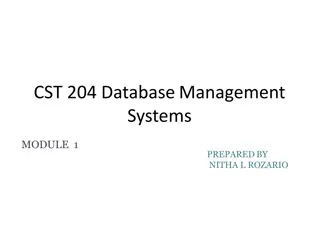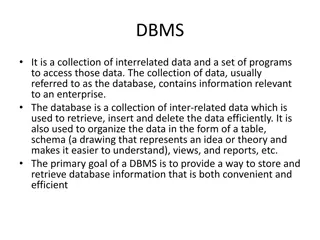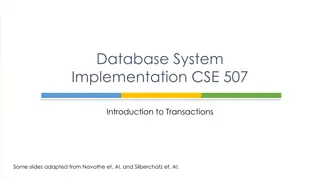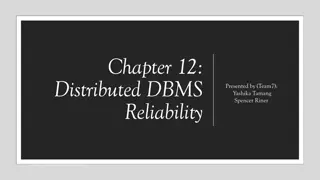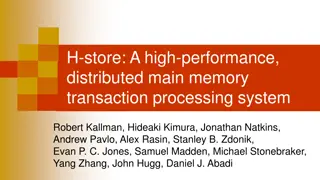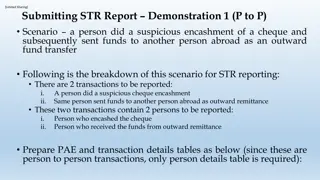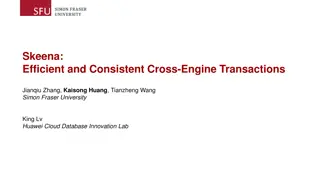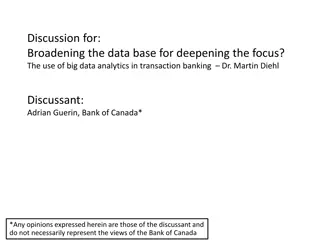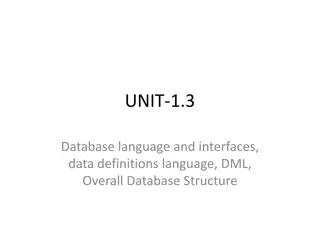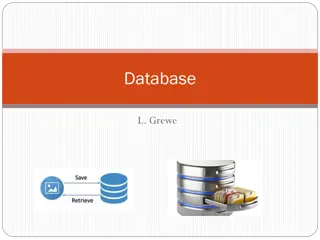Understanding Transaction Management in DBMS
In this lecture, Mohammad Hammoud covers the key aspects of transaction management in database management systems (DBMS). Topics include locking protocols, anomaly avoidance, lock managers, and two-phase locking. The session delves into the rules, data structures, and processes involved in maintaining transaction integrity within a DBMS environment.
Download Presentation

Please find below an Image/Link to download the presentation.
The content on the website is provided AS IS for your information and personal use only. It may not be sold, licensed, or shared on other websites without obtaining consent from the author. Download presentation by click this link. If you encounter any issues during the download, it is possible that the publisher has removed the file from their server.
E N D
Presentation Transcript
Database Applications (15-415) DBMS Internals- Part XII Lecture 25, April 19, 2020 Mohammad Hammoud
Today Last Two Sessions: DBMS Internals- Part XI Transaction Management Today s Session: Transaction Management (Continue) Announcement: PS5 is now posted. It is due on Thursday, April 23
DBMS Layers Queries Query Optimization and Execution Relational Operators Files and Access Methods Transaction Manager Recovery Manager Buffer Management Lock Manager Disk Space Management DB
Outline A Brief Primer on Transaction Management Anomalies Due to Concurrency 2PL and Strict 2PL Locking Protocols Schedules with Aborted Transactions
Locking Protocols WR, RW and WW anomalies can be avoided using a locking protocol A locking protocol: Is a set of rules to be followed by each transaction to ensure that only serializable schedules are allowed (extended later) Associates a lock with each database object, which could be of different types (e.g., shared or exclusive) Grants and denies locks to transactions according to the specified rules The part of the DBMS that keeps track of locks is called the lock manager
Lock Managers Usually, a lock manager in a DBMS maintains three types of data structures: A queue, Q, for each lock, L, to hold its pending requests Transaction Table Transaction List 1 (LS1) Trx List T1 LS1 Lock Queue 1 (Q1) Lock Table A lock table, which keeps for each L associated with each object, O, a record R that contains: The type of L (e.g., shared or exclusive) The number of transactions currently holding L on O A pointer to Q Object Lock # Type # of Trx Q O L S 1 Q1 A transaction table, which maintains for each transaction, T, a pointer to a list of locks held by T
Two-Phase Locking A widely used locking protocol, called Two-Phase Locking (2PL), has two rules: Rule 1: if a transaction T wants to read (or write) an object O, it first requests the lock manager for a shared (or exclusive) lock on O T0 T1 T2 T0 T1 T2 T0 T1 T2 Write Request on Object O Shared Lock Granted Lock Denied Read Request on Object O Read Request on Object O Shared Lock Granted Queue 2 Queue Lock Manager Queue Lock Manager Lock Manager t2 t0 t1 Time
Two-Phase Locking A widely used locking protocol, called Two-Phase Locking (2PL), has two rules: Rule 1: if a transaction T wants to read (or write) an object O, it first requests the lock manager for a shared (or exclusive) lock on O T0 T1 T2 T0 T1 T2 T0 T1 T2 Exclusive Lock Granted Release Lock on Object O Release Lock on Object O Queue 2 Queue 2 2 Lock Manager Queue Lock Manager Lock Manager t5 t3 t4 Time
Two-Phase Locking A widely used locking protocol, called Two-Phase Locking (2PL), has two rules: Rule 1: if a transaction T wants to read (or write) an object O, it first requests the lock manager for a shared (or exclusive) lock on O T0 T1 T2 T0 T1 T2 T0 T1 T2 Release Lock on Object O Read Request on Object O Lock Denied Read Request on Object O Lock Denied Queue 1 1 Queue 1 Lock Manager Queue Lock Manager Lock Manager 0 0 t8 t6 t7 Time
Two-Phase Locking A widely used locking protocol, called Two-Phase Locking (2PL), has two rules: Rule 1: if a transaction T wants to read (or write) an object O, it first requests the lock manager for a shared (or exclusive) lock on O T0 T1 T2 T0 T1 T2 T0 T1 T2 Write Request on Object O Shared Lock Granted Lock Denied Shared Lock Granted Queue 2 1 Queue Lock Manager Queue 0 Lock Manager Lock Manager 0 t10 t9 t9 Time
Two-Phase Locking A widely used locking protocol, called Two-Phase Locking (2PL), has two rules: Rule 2: T can release locks before it commits or aborts, and cannot request additional locks once it releases any lock Thus, every transaction has a growing phase in which it acquires locks, followed by a shrinking phase in which it releases locks # locks shrinking phase growing phase
Two-Phase Locking A widely used locking protocol, called Two-Phase Locking (2PL), has two rules: Rule 2: T can release locks before it commits or aborts, and cannot request additional locks once it releases any lock Thus, every transaction has a growing phase in which it acquires locks, followed by a shrinking phase in which it releases locks # locks violation of 2PL
Resolving RW Conflicts Using 2PL Suppose that T1 and T2 actions are interleaved as follows: T1 reads A T2 reads A, decrements A and commits T1 tries to decrement A T1 and T2 can be represented by the following schedule: T1 T2 T1 T2 EXCLUSIVE(A) R(A) R(A) RW R(A) W(A) Commit Lock(A) Conflict Resolved! W(A) Commit Wait W(A) Commit EXCLUSIVE(A) R(A) W(A) Commit Exposes RW Anomaly
Resolving RW Conflicts Using 2PL Suppose that T1 and T2 actions are interleaved as follows: T1 reads A T2 reads A, decrements A and commits T1 tries to decrement A T1 and T2 can be represented by the following schedule: T1 T2 T1 T2 EXCLUSIVE(A) R(A) R(A) But, it can limit parallelism! R(A) W(A) Commit Lock(A) W(A) Commit Wait W(A) Commit EXCLUSIVE(A) R(A) W(A) Commit Exposes RW Anomaly
Resolving WW Conflicts Using 2PL Suppose that T1 and T2 actions are interleaved as follows: T1 sets Mohammad s Salary to $1000 T2 sets Ahmad s Salary to $2000 T1 sets Ahmad s Salary to $1000 T2 sets Mohammad s Salary to $2000 T1 and T2 can be represented by the following schedule: T1 T2 T1 T2 EXCLUSIVE(MS) EXCLUSIVE(AS) W(MS) W(AS) Commit WW Conflict Resolved! W(MS) Lock(AS) W(AS) W(AS) Commit Wait W(MS) Commit EXCLUSIVE(AS) EXCLUSIVE(MS) W(AS) W(MS) Commit Exposes WW Anomaly (assuming, MS & AS must be kept equal)
Resolving WW Conflicts Using 2PL Suppose that T1 and T2 actions are interleaved as follows: T1 sets Mohammad s Salary to $1000 T2 sets Ahmad s Salary to $2000 T1 sets Ahmad s Salary to $1000 T2 sets Mohammad s Salary to $2000 T1 and T2 can be represented by the following schedule: T1 T2 T1 T2 EXCLUSIVE(MS) W(MS) Lock(AS) W(MS) EXCLUSIVE(AS) W(AS) Lock(MS) W(AS) W(AS) Commit W(MS) Commit Wait Wait Exposes WW Anomaly (assuming, MS & AS must be kept equal) Deadlock!
Resolving WR Conflicts Suppose that T1 and T2 actions are interleaved as follows: T1 deducts $100 from account A T2 adds 6% interest to accounts A and B T1 credits $100 to account B T1 and T2 can be represented by the following schedule: T1 T2 R(A) W(A) R(A) W(A) R(B) W(B) Commit T1 T2 EXCLUSIVE(A) EXCLUSIVE(B) R(A) W(A) R(B) W(B) Commit WR Lock(A) Lock(B) Conflict Resolved! Wait EXCLUSIVE(A) EXCLUSIVE(B) R(A) W(A) R(B) W(B) Commit R(B) W(B) Commit Exposes WR Anomaly
Resolving WR Conflicts Suppose that T1 and T2 actions are interleaved as follows: T1 deducts $100 from account A T2 adds 6% interest to accounts A and B T1 credits $100 to account B T1 and T2 can be represented by the following schedule: T1 T2 R(A) W(A) R(A) W(A) R(B) W(B) Commit T1 T2 EXCLUSIVE(A) EXCLUSIVE(B) R(A) W(A) RELEASE(A) R(B) W(B) Commit Lock(A) Lock(B) WR Conflict is NOT Resolved! Wait EXCLUSIVE(A) R(A) W(A) EXCLUSIVE(B) R(B) W(B) Commit R(B) W(B) Commit How can we solve this? Exposes WR Anomaly
Strict Two-Phase Locking WR conflicts (as well as RW & WW) can be solved by making 2PL stricter In particular, Rule 2 in 2PL can be modified as follows: Rule 2: locks of a transaction T can only be released after T completes (i.e., commits or aborts) This version of 2PL is called Strict Two-Phase Locking
Resolving WR Conflicts: Revisit Suppose that T1 and T2 actions are interleaved as follows: T1 deducts $100 from account A T2 adds 6% interest to accounts A and B T1 credits $100 to account B T1 and T2 can be represented by the following schedule: T1 T2 R(A) W(A) R(A) W(A) R(B) W(B) Commit T1 T2 EXCLUSIVE(A) EXCLUSIVE(B) R(A) W(A) RELEASE(A) R(B) W(B) Commit Lock(A) Lock(B) Wait EXCLUSIVE(A) R(A) W(A) EXCLUSIVE(B) R(B) W(B) Commit R(B) W(B) Commit Exposes WR Anomaly Not allowed with strict 2PL
Resolving WR Conflicts: Revisit Suppose that T1 and T2 actions are interleaved as follows: T1 deducts $100 from account A T2 adds 6% interest to accounts A and B T1 credits $100 to account B T1 and T2 can be represented by the following schedule: T1 T2 R(A) W(A) R(A) W(A) R(B) W(B) Commit T1 T2 EXCLUSIVE(A) EXCLUSIVE(B) R(A) W(A) R(B) W(B) Commit WR Conflict is Resolved! Lock(A) Lock(B) Wait But, EXCLUSIVE(A) EXCLUSIVE(B) R(A) W(A) R(B) W(B) Commit R(B) W(B) Commit parallelism is limited more! Exposes WR Anomaly
2PL vs. Strict 2PL T1 T2 Two-Phase Locking (2PL): Limits concurrency May lead to deadlocks May have dirty reads SHARED(A) R(A) SHARED(A) R(A) EXECLUSIVE(B) R(B) W(B) Commit EXCLUSIVE(C) R(C) W(C) Commit Strict 2PL: Limits concurrency more (but, actions of different transactions can still be interleaved) May still lead to deadlocks Avoids dirty reads A Schedule with Strict 2PL and Interleaved Actions
Performance of Locking Locking comes with delays mainly from blocking Usually, the first few transactions are unlikely to conflict Throughput can rise in proportion to the number of active transactions As more transactions are executed concurrently, the likelihood of blocking increases Throughput will increase more slowly with the number of active transactions There comes a point when adding another active transaction will actually decrease throughput When the system thrashes!
Performance of Locking (Contd) Throughput Thrashing # of Active Transactions If a database begins to thrash, the DBA should reduce the number of active transactions Empirically, thrashing is seen to occur when 30% of active transactions are blocked!
Outline A Brief Primer on Transaction Management Anomalies Due to Concurrency 2PL and Strict 2PL Locking Protocols Schedules with Aborted Transactions
Schedules with Aborted Transactions Suppose that T1 and T2 actions are interleaved as follows: T1 deducts $100 from account A T2 adds 6% interest to accounts A and B, and commits T1 is aborted T1 and T2 can be represented by the following schedule: T1 T2 R(A) W(A) T2 read a value for A that should have never been there! R(A) W(A) R(B) W(B) Commit How can we deal with the situation, assuming T2 had not yet committed? Abort
Schedules with Aborted Transactions Suppose that T1 and T2 actions are interleaved as follows: T1 deducts $100 from account A T2 adds 6% interest to accounts A and B, and commits T1 is aborted T1 and T2 can be represented by the following schedule: T1 T2 R(A) W(A) T2 read a value for A that should have never been there! R(A) W(A) R(B) W(B) Commit We can cascade the abort of T1 by aborting T2 as well! This cascading process can be recursively applied to any transaction that read A written by T1 Abort
Schedules with Aborted Transactions Suppose that T1 and T2 actions are interleaved as follows: T1 deducts $100 from account A T2 adds 6% interest to accounts A and B, and commits T1 is aborted T1 and T2 can be represented by the following schedule: T1 T2 R(A) W(A) T2 read a value for A that should have never been there! R(A) W(A) R(B) W(B) Commit How can we deal with the situation, assuming T2 had actually committed? The schedule is indeed unrecoverable! Abort
Schedules with Aborted Transactions Suppose that T1 and T2 actions are interleaved as follows: T1 deducts $100 from account A T2 adds 6% interest to accounts A and B, and commits T1 is aborted T1 and T2 can be represented by the following schedule: T1 T2 R(A) W(A) T2 read a value for A that should have never been there! R(A) W(A) R(B) W(B) Commit For a schedule to be recoverable, transactions should commit only after all transactions whose changes they read commit! Abort Recoverable schedules avoid cascading aborts!
Schedules with Aborted Transactions Suppose that T1 and T2 actions are interleaved as follows: T1 deducts $100 from account A T2 adds 6% interest to accounts A and B, and commits T1 is aborted T1 and T2 can be represented by the following schedule: T1 T2 R(A) W(A) T2 read a value for A that should have never been there! R(A) W(A) R(B) W(B) Commit How can we ensure recoverable schedules ? By using Strict 2PL! Abort
Schedules with Aborted Transactions Suppose that T1 and T2 actions are interleaved as follows: T1 deducts $100 from account A T2 adds 6% interest to accounts A and B, and commits T1 is aborted T1 and T2 can be represented by the following schedule: T1 T2 EXCLUSIVE(A) R(A) W(A) T1 T2 Cascaded aborts are avoided! R(A) W(A) Lock(A) Wait Abort UNDO(T1) R(A) W(A) R(B) W(B) Commit EXCLUSIVE(A) R(A) W(A) EXCLUSIVE(B) R(B) W(B) Commit Abort
Serializable Schedules: Redefined Two schedules are said to be equivalent if for any database state, the effect of executing the 1st schedule is identical to the effect of executing the 2nd schedule Previously: a serializable schedule is a schedule that is equivalent to a serial schedule Now: a serializable schedule is a schedule that is equivalent to a serial schedule over a set of committed transactions This definition captures serializability as well as recoverability
Now Lock Conversions Dealing with Deadlocks Dynamic Databases and the Phantom Problem Concurrency Control in B+ Trees
Lock Conversions A transaction may need to change the lock it already acquires on an object From Shared to Exclusive This is referred to as lock upgrade From Exclusive to Shared This is referred to as lock downgrade For example, an SQL update statement might acquire a Shared lock on each row, R, in a table and if R satisfies the condition (in the WHERE clause), an Exclusive lock must be obtained for R
Lock Upgrades A lock upgrade request from a transaction T on object O must be handled specially by: Granting an Exclusive lock to T immediately if no other transaction holds a lock on O Otherwise, queuing T at the front of O s queue (i.e., T is favored) T is favored because it already holds a Shared lock on O Queuing T in front of another transaction T that holds no lock on O, but requested an Exclusive lock on O averts a deadlock! However, if T and T hold a Shared lock on O, and both request upgrades to an Exclusive lock, a deadlock will arise regardless!
Lock Downgrades Lock upgrades can be entirely avoided by obtaining Exclusive locks initially, and downgrade them to Shared locks once needed Would this violate any 2PL requirement? On the surface yes; since the transaction (say, T) may need to upgrade later This is a special case as Tconservatively obtained an Exclusive lock, and did nothing but read the object that it downgraded 2PL can be safely extended to allow lock downgrades in the growing phase, provided that the transaction has not modified the object
Outline Lock Conversions Dealing with Deadlocks Dynamic Databases and the Phantom Problem Concurrency Control in B+ Trees
Deadlock Detection The lock manager maintains a structure called a waits-for graph to periodically detect deadlocks In a waits-for graph: The nodes correspond to active transactions There is an edge from Ti to Tj if and only if Ti is waiting for Tj to release a lock The lock manager adds and removes edges to and from a waits-for graph when it queues and grants lock requests, respectively A deadlock is detected when a cycle in the waits-for graph is found
Deadlock Detection (Contd) The following schedule is free of deadlocks: T3 T4 T1 T2 S(A) R(A) T1 T2 X(B) W(B) S(B) S(C) R(C) T4 T3 X(C) X(B) No cycles; hence, no deadlocks! The Corresponding Waits-For Graph* A schedule without a deadlock *The nodes correspond to active transactions and there is an edge from Ti to Tj if and only if Ti is waiting for Tj to release a lock
Deadlock Detection (Contd) The following schedule is NOT free of deadlocks: T3 T4 T1 T2 S(A) R(A) T1 T2 X(B) W(B) S(B) S(C) R(C) T4 T3 X(C) X(B) X(A) The Corresponding Waits-For Graph* A schedule with a deadlock *The nodes correspond to active transactions and there is an edge from Ti to Tj if and only if Ti is waiting for Tj to release a lock
Deadlock Detection (Contd) The following schedule is NOT free of deadlocks: T3 T4 T1 T2 S(A) R(A) T1 T2 X(B) W(B) S(B) S(C) R(C) T4 T3 X(C) X(B) X(A) Cycle detected; hence, a deadlock! The Corresponding Waits-For Graph* A schedule with a deadlock *The nodes correspond to active transactions and there is an edge from Ti to Tj if and only if Ti is waiting for Tj to release a lock
Resolving Deadlocks A deadlock is resolved by aborting a transaction that is on a cycle and releasing its locks This allows some of the waiting transactions to proceed The choice of which transaction to abort can be made using different criteria: The one with the fewest locks Or the one that has done the least work Or the one that is farthest from completion (more accurate) Caveat: a transaction that was aborted in the past, should be favored subsequently and not aborted upon a deadlock detection!
Deadlock Prevention Studies indicate that deadlocks are relatively infrequent and detection-based schemes work well in practice However, if there is a high level of contention for locks, prevention-based schemes could perform better Deadlocks can be averted by giving each transaction a priority and ensuring that lower-priority transactions are not allowed to wait for higher-priority ones (or vice versa)
Deadlock Prevention (Contd) One way to assign priorities is to give each transaction a timestamp when it is started Thus, the lower the timestamp, the higher is the transaction s priority If a transaction Ti requests a lock and a transaction Tj holds a conflicting lock, the lock manager can use one of the following policies: Wound-Wait: If Ti has higher priority, Tj is aborted; otherwise, Ti waits Wait-Die: If Ti has higher priority, it is allowed to wait; otherwise, it is aborted
Reissuing Timestamps A subtle point is that we must ensure that no transaction is perennially aborted because it never had a sufficiently high priority To avoid that, when a transaction is aborted and restarted, it should be given the same timestamp it had originally This policy is referred to as reissuing timestamps Reissuing timestamps ensures that each transaction will eventually become the oldest and accordingly get all the locks it requires!
Outline Lock Conversions Dealing with Deadlocks Dynamic Databases and the Phantom Problem Concurrency Control in B+ Trees
Dynamic Databases Thus far, we have assumed static databases We now relax that condition and assume dynamic databases (i.e., databases that grow and shrink) To study locking protocols for dynamic databases, we consider the following: A Sailors relation S A transaction T1 which only scans S to find the oldest Sailor for specific rating levels A transaction T2 which updates Sailor while T1 is running
A Possible Scenario Assume a scenario whereby the actions of T1 and T2 are interleavedas follows: T1 identifies all pages containing Sailors with rating 1 (say, pages A and B) T1 finds the age of the oldest Sailor with rating 1 (say, 71) T2 inserts a new Sailor with rating 1 and age 96 (perhaps into page C which does not contain any Sailor with rating 1) T2 locates the page containing the oldest Sailor with rating 2 (say, page D) and deletes this Sailor (whose age is, say, 80) T2 commits T1 identifies all pages containing Sailors with rating 2 (say pages D and E), and finds the age of the oldest such Sailor (which is, say, 63) T1 commits
A Possible Scenario (Contd) We can apply strict 2PL to the given interleaved actions of T1 and T2 as follows (S = Shared; X = Exclusive): T1 T2 T1 T2 S(A) R(A) S(B) R(B) R(A) R(B) R(C) W(C) R(D) W(D) Commit E(C) R(C) W(C) E(D) R(D) W(D) Commit R(D) R(E) Commit S(D) R(D) S(E) R(E) Commit
A Possible Scenario (Contd) We can apply strict 2PL to the given interleaved actions of T1 and T2 as follows (S = Shared; X = Exclusive): T1 T2 T1 T2 S(A) R(A) S(B) R(B) R(A) R(B) R(C) W(C) R(D) W(D) Commit E(C) R(C) W(C) E(D) R(D) W(D) Commit A tuple with rating 1 and age 71 is returned R(D) R(E) Commit A tuple with rating 1 and age 96 is inserted A tuple with rating 2 and age 63 is returned S(D) R(D) S(E) R(E) Commit A tuple with rating 2 and age 80 is deleted




